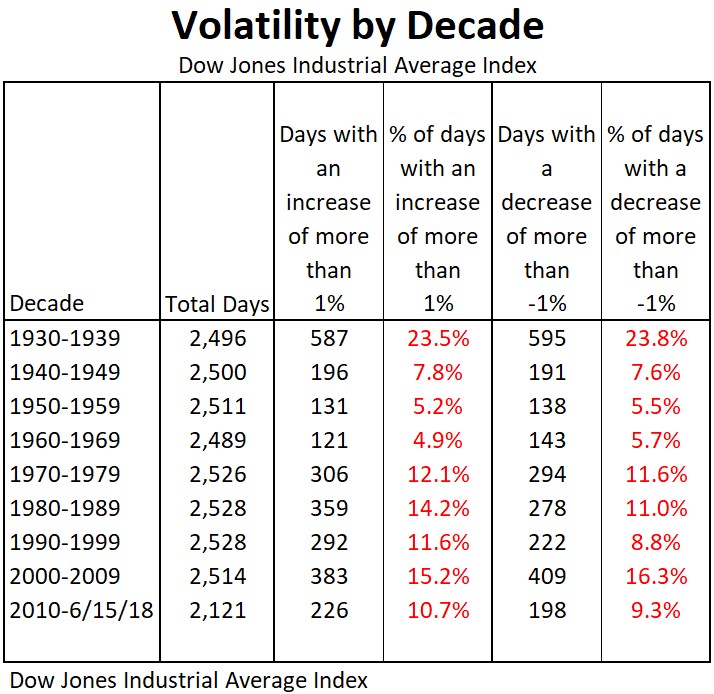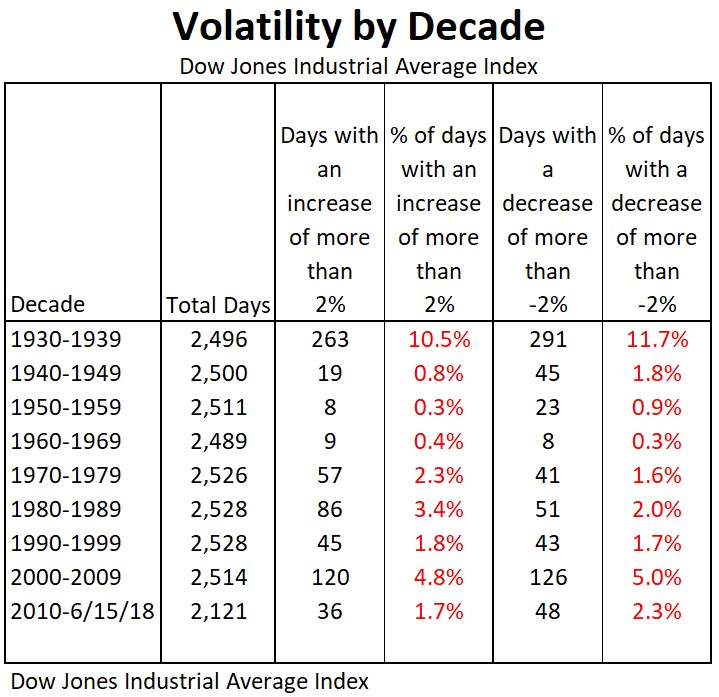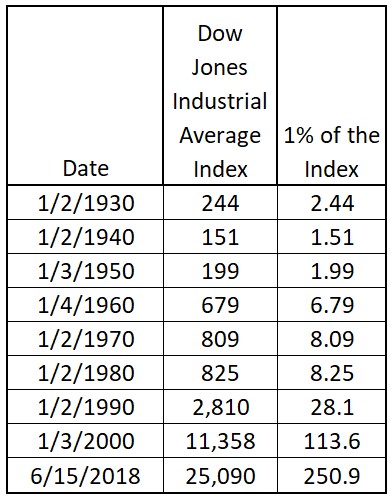Is the Stock Market More Volatile Now Than Ever Before?
Daily swings of 200 or 300 points can leave investors feeling more than a little unnerved, but a deeper dive into the numbers over the years may reveal a truth that could help calm those jitters down a bit.


Since I began working in the financial services industry in 1987, I’ve noticed that investors seem to continually feel that the current stock market has been more volatile than it was in the previous five or 10 years. This thinking was brought to my attention once again recently when a client indicated that they felt like the stock market today was more volatile than it has been in the past. I agreed that it sure feels that way. But is it really?
I decided to do some research, and I was a little surprised at what I found.
Today it’s not uncommon to have the Dow Jones Industrial Average, a measure of large U.S. company stocks, swing up or down 100 points in a day. In fact, it’s not uncommon to have moves of 200-300 points in a single day. That sounds volatile, right? However, when we dig deeper we find there is more to the story.

Sign up for Kiplinger’s Free E-Newsletters
Profit and prosper with the best of expert advice on investing, taxes, retirement, personal finance and more - straight to your e-mail.
Profit and prosper with the best of expert advice - straight to your e-mail.
In the chart below I looked at each decade starting in the 1930s and outlined the number of days that the stock market rose or fell more than 1%. What you notice is that since 2010 the number of such days is actually lower than during the previous four decades (1970-2009). So far this decade 11% of the days have been up more than 1% and 9% of the days have been down more than 1%.

I also looked at days when the index rose or fell 2% or more. The results below show that stock market volatility since 2010 has been quite similar to past decades.

If current stock market volatility is similar to that of the past, why does it feel so much more volatile? The reason is actually quite simple. The index is much larger now, so a 1% move up or down represents a far greater number of points. As you can see in the chart below, on the first trading day of 1980 the Dow closed at 825. One percent of 825 is 8.25 points. Since then the stock market has climbed. By June 15, 2018, the index was up to 25,090. One percent of 25,090 is 250.9 points. So, if the stock market, as measured by the Dow, is now at 25,090 and falls 250.9 points, that is the same as an 8.25-point drop in 1980.

Investors hardly notice days when the Dow drops 8 points now, so naturally when it drops 250 points they feel like volatility has gone sky high by comparison. As you can see, in order to measure volatility, we need to look at the percentage increases and decreases as opposed to the point increases and decreases to get an accurate impression.
Volatility since 2010, as measured by a daily drop or gain of more or less than 1%, has actually been lower than it has been compared to many past decades. Consequently, there is no reason for alarm.
Get Kiplinger Today newsletter — free
Profit and prosper with the best of Kiplinger's advice on investing, taxes, retirement, personal finance and much more. Delivered daily. Enter your email in the box and click Sign Me Up.

Ray LeVitre is an independent fee-only Certified Financial Adviser with over 20 years of financial services experience. In addition he is the founder of Net Worth Advisory Group and the author of "20 Retirement Decisions You Need to Make Right Now."
-
 Designing Your 'Immortal' Financial Plan
Designing Your 'Immortal' Financial PlanExplore an approach that offers solutions for those navigating the intersection of longevity, fulfillment and financial security.
By Dennis McNamara
-
 How to Protect Your Privacy While Using AI
How to Protect Your Privacy While Using AIHow to keep your information and finances safe while using AI, including ChatGPT and Perplexity.
By Bob Haegele
-
 A QLAC Does So Much More Than Simply Defer Taxes
A QLAC Does So Much More Than Simply Defer TaxesHere are the multiple ways you can use a QLAC, from managing retirement risks to creating income for specific retirement needs and wants.
By Jerry Golden, Investment Adviser Representative
-
 Self-Directed Brokerage Accounts: Retirement's Hidden Gem?
Self-Directed Brokerage Accounts: Retirement's Hidden Gem?SDBAs are underused and have a reputation for being risky, but when managed carefully they can help you grow your wealth faster than your company's 401(k).
By Scott M. Dougan, RFC, Investment Adviser
-
 Early-Stage Startup Deals: How Does a SAFE Work?
Early-Stage Startup Deals: How Does a SAFE Work?Investing in an early-stage startup can get complicated fast, so the venture capital industry turns to other investing options. One is a SAFE.
By Murat Abdrakhmanov
-
 Should You Hire a Public Adjuster for Your Insurance Claim?
Should You Hire a Public Adjuster for Your Insurance Claim?As natural disasters strike more often, insurance clients are asking, 'What should I do, or who should I hire, if my insurance company is jerking me around?'
By H. Dennis Beaver, Esq.
-
 Tips to Help Entrepreneurs Create Self-Sustaining Businesses
Tips to Help Entrepreneurs Create Self-Sustaining BusinessesWith the right processes and people in place, a truly sustainable business can be efficiently passed on to a successor and run profitably on its own.
By Jason L Smith, CEP®, BPC
-
 Navigating Annuity Taxation: A Guide for Financial Advisers
Navigating Annuity Taxation: A Guide for Financial AdvisersUnderstanding the essentials of taxation in retirement income strategies involving annuities helps ensure positive outcomes for clients.
By Jake Klima
-
 How Google Reviews Can Help (or Hurt) Financial Advisers
How Google Reviews Can Help (or Hurt) Financial AdvisersDon't leave your Google Business Profile unclaimed — someone else can make changes if they claim it. Also, here's what you can (and cannot) do with the reviews.
By Jeff Briskin
-
 How Baby Boomers and Gen Xers Are Redefining Retirement Living
How Baby Boomers and Gen Xers Are Redefining Retirement LivingBoth generations need to embrace change and leverage real estate as a dynamic asset in their retirement planning. Here's how financial advisers can help, too.
By David Conti, CPRC